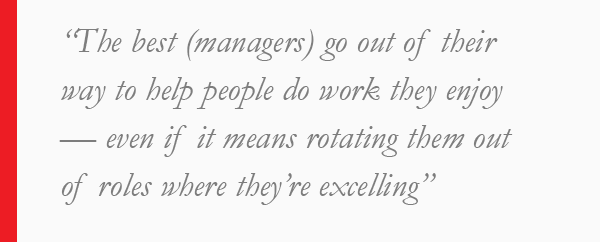— October 20, 2018
How do you find the best talent for your agency? What can you do to attract better – and retain – better employees? This guide shares some answers and insight.
Ask an agency founder about his biggest challenges and you’ll often get the same answer: hiring.
In a people-focused industry, the kind of talent you can attract and retain is crucial. A smart and creative talent pool isn’t just a competitive advantage; it’s a necessity.
But as agency vets will tell you, hiring is hard. Between a growing skills gap and a burgeoning war for talent, you have your hands full finding people (and getting them to stay).
We covered hiring remote workers earlier, but the bigger question of agency hiring remains unanswered. So in this guide, I’ll share some answers to hiring the best creative talent for your agency.

The Two Factors Affecting Agency Hiring
At its heart, agency hiring is a simple process: find good people, get them to stay.
In the golden days of the Mad Men era, both of these were easy enough. Creative people had few lucrative employment opportunities outside of agencies. You could either plod along as an unpaid poet, or create world-changing campaigns as a copywriter.
That’s not true today anymore. A talented creative has countless opportunities. There is a war for talent and agency attrition rates are skyrocketing.
If you are to create an effective hiring process, you have to first confront these two realities.
Confronting the War for Talent
Post a job for a current opening and you’ll get inundated with hundreds of applications.
With such numbers, it’s easy to fall into the trap of thinking that there is plenty of talent out there.
But these numbers mask the fact that the best talent is almost always already employed. Worse, they’re often working in positions they’re unlikely to leave, even if you dangle the juiciest of carrots.
There are two reasons behind this sudden competition for talent:
- The emergence of consultancies as a legitimate threat to agencies. Consultancies have deep coffers, management expertise, and strong employer brands – attractive qualities for experienced employees.
- Technology companies luring away creative employees, often with steep salaries and perks. As tech companies move away from hard tech to more creative, design-focused products, they’re in direct competition with agencies.
This talent war isn’t just being played out at the lower rungs; top agency execs, too, are leaving for other pastures. Tor Myhren, Grey’s former CCO, switched to Apple. TBWA Rudi Anggono left for Google’s in-house agency. And so on.

If you want better talent, you have to fight off competition from consultancies and tech firms. But you can’t really do it on their terms. You don’t have coffers as deep as Deloitte or Google. Nor can you match a Facebook or an Amazon in perks and stock options.
What you can do is focus on what agencies do best: creativity, culture, and strategy. You have to design a hiring process and an employer brand that emphasizes everything that makes agencies unique.
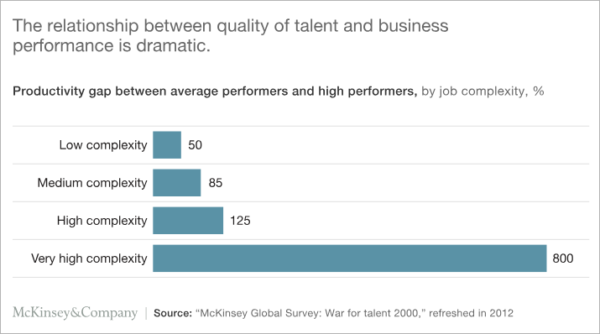
Why talent matters: top performers in complex tasks are 800% more productive than average performers (Source: McKinsey)
Controlling Attrition Rates
You don’t have to be reminded that agency attrition rates are among the highest in the world. Part of this is because of the intense competition from players outside the industry – consultancies and tech firms. The bigger part, however, is because of talent flight to other agencies.
Why do people switch from one agency to another?
Some of the culprits are the usual – better pay, better perks. Combating these is fairly straightforward: offer higher salaries and more benefits (which might mean raising your rates).
But two other reasons require a broader reorganizing of your agency. These are:
- Career opportunities: In a LinkedIn and 4A survey, 54% of respondents said they switched agencies because of lack of career opportunities and learning.
- Quality of work: In the same survey, the quality of work was the second biggest reason for employee attrition.
Creative people don’t want to work on mundane problems. Nor do they want their skills to stagnate. An agency that focuses on procedural rather than inspirational solutions is going to find it hard to retain its people. You are, after all, competing with Silicon Valley stalwarts who claim to “change the world”.
In the sections to follow, I’ll discuss some of the things you can do to hire better talent for your agency.

How to Attract (and Retain) Better Agency Talent
I don’t have to sell you on the benefits of having better employees. You already know that better talent equals happier clients and healthier agencies.
But the mistake most agencies make is viewing the hiring process in isolation. They look for ‘tricks and tactics’ to lure in the best employees, without thinking about how the rest of the agency operates.
Your hiring process is a reflection of your agency. You can’t fake an exciting, employee-friendly agency brand with brightly lit offices and free Friday meals. Top talent can spot when you’re playing dress-up from a mile away.
Rather, to hire better people, you have to fundamentally change your agency to be something top talent would want to work with.
How?
Let’s find out.
1. Do One Thing ‘Great’
Top talent doesn’t want to work for just any business. They want to work with companies that have at least one distinctive feature.
A McKinsey survey found that this distinctiveness can be in the form of a great job, great leaders, great company, or great perks.
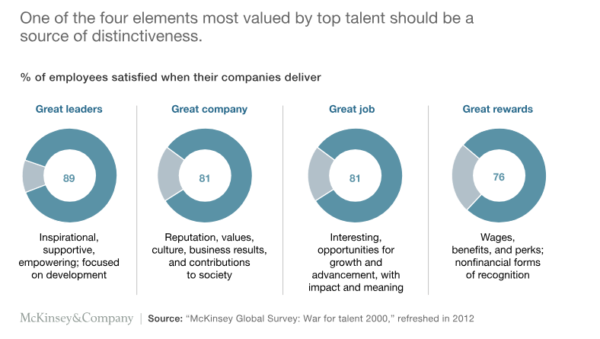
A company helmed by a storied founder (say, Elon Musk) would find it easy to attract talent because of the reputation of the founder. Another company known to be a good employer (like Google) would attract talent because people want to work for a known “great” company.
Too many agencies, however, doom themselves to sameness. From the perks to the job description, nothing stands out. Showing that you’re “average” can only help you attract average talent at best.
To combat this, focus your entire recruitment strategy on the one thing that makes you “great”. Maybe you’re the most-awarded agency in your region. Maybe the founder has a TED talk with 5M views. Or maybe your job has the best perks anyone can imagine.
Find the one thing that you can claim to be great at, and focus on it your hiring.
2. Change Your Positioning
Quality work attracts quality talent. But too many agencies are stuck chasing cheap clients and dull, procedural solutions.
This creates a vicious cycle where you’re unable to attract top talent because you don’t do meaningful work. And because you don’t have top talent, you’re unable to attract better clients.
Breaking out of this cycle requires a concentrated effort. You have to actively pursue a positioning strategy that makes you attractive to clients (and by proxy, to employees).
The first step in this process is to evaluate the gap between where you are and where you want to be. Study how you market yourself. Then compare it to industry leaders. What do they do differently from you? Can you adopt any of their tactics to attract better quality clients?
This isn’t just about hiring, of course. Changing your positioning essentially means changing your agency. But if you want better paying work and better employees, it’s a worthwhile investment.
Refer to this guide to learn how to get the right agency positioning.
3. Improve Your Employer-Brand Visibility
When you tell prospective hires about your agency, do you hear a bewildered “who?”
Agencies invest a lot in marketing their brand to clients. But in the process, they often neglect their employer-brand. It’s not unusual to find an agency that is well-known among prospective clients but completely unknown to prospective employees.
This happens because your clients and employees don’t hang out on the same platforms. A client might read CMO magazine and HBR. But a designer you want to hire might spend all his time on Reddit and SmashingMagazine.
If you want to attract better employees, you have to raise your brand visibility among potential employees. Don’t just focus on promoting your brand to clients; find out where your target talent hangs out and reach out to them as well.

BBDO’s SF office has a popular Instagram channel that is focused almost exclusively on promoting its employer brand. (Image source)
Here are some tactics to do this:
- Develop an employee advocacy program where you encourage your existing employees to promote your agency on channels they themselves use.
- Appoint an ‘evangelist’ who can promote your agency. This can be a formal or an informal role. The evangelist operates at the intersection of sales, training, and marketing.
- Invest in thought leadership, especially on platforms used by talent you want to target.
- Establish a presence on relevant platforms and forums. Monitor your brand mentions and pop-in to answer questions. You have to show that you’re consuming the same media as the people you want to hire.
- Create talent-focused content, including blog posts, off-site guest posts, and videos that paint your business in a positive light.
- Use PR to get your business mentioned in roundups and articles, especially on publications frequented by your target audience. A spot in a “best place to work” ranking can do wonders for your visibility.
Some of the world’s top agencies devote a significant amount of resources to promoting their employer brand. Platforms such as Instagram, for instance, are not particularly useful for finding clients. But since they’re used by your target talent, a strong presence on them can help build your brand.
4. Find Your Best Employees (and Take Care of Them)
In its paper on how to win the talent war, McKinsey had one piece of advice:
“Focus on the 5 percent who deliver 95 percent of the value”
Every agency has some obvious superstars – highly visible employees who deliver stellar results time after time. Given their visibility, managers usually take special care of their workplace needs.
But there is another coterie of equally talented employees who often go unrecognized because of their roles or personalities. In agencies, it’s not unusual for top creative talent to hog the limelight while equally important support staff gets sidelined.
Since they don’t get the recognition they deserve, this talent is a prime target for attrition.
One of your top priorities should be to find these “anti-superstar” employees and take good care of them. Look for:
- Strong creative performers in non-client-facing roles
- Top performers in “uncool” but business-critical areas such as finance, IT, and sales.
- “Connectors” who know and connect several different teams. These people are often crucial for fostering collaboration.
Once you’ve spotted these top performers (a data-focused project management tool – like Workamajig – can help), you need to go out of your way to retain them.
How? Here are some tactics:
- Understand what kind of work your top talent likes doing, and assign them to relevant projects.
- Offer flexible benefits based on the employee’s changing needs.
- Look beyond fixed roles. Instead, focus on getting people into projects where their passion will be best utilized.
- Figure out which employees work best together. Create teams with such employees.
As Facebook’s HR leaders, writing in HBR say:
5. Focus on Your Culture
There are few words more abused in hiring than ‘culture’. Agencies like to sprinkle it around their job descriptions, repeating the same tired maxims of being “fun”, “creative”, and “inclusive”.
But how many agencies actually live the values they espouse?
Culture is a tough nut to crack since it isn’t about what you do; it’s about who you are. It’s not a tactic or a technique that can be implemented overnight. Rather, it’s an amalgamation of every aspect of your agency.

Culture is also the one thing that sets you apart from competitors. You might not be able to offer the same salaries as Google, but you can offer better culture.
I’ve written extensively about scaling your culture and building an inclusive culture in the past. Consider this a long-term exercise in finding the “soul” of your agency. How you do this will depend on your circumstances, but the following approaches can help:
- Formalize your agency’s core values early, and revise them often.
- Distill your agency’s “mission” to a short, punchy sentence. Think BBDO’s “The Work, The Work, The Work” mantra.
- Adopt a common vocabulary across the company, sort of your agency-wide “in-joke”.
- Use storytelling, especially during onboarding, to help new hires understand who you are.

The six word “mantra” Brian Acton used when building Whatsapp (Source: BusinessInsider)
Focusing on your culture should be a top priority in all hiring. It’s the one thing that can help you stand out.
6. Optimize Your Hiring Process
You can have the best culture and strongest employer brand possible, but it won’t matter if your hiring process itself is broken.
Your hiring process should be designed for efficiency and relevance. You want to reach targeted talent and filter out candidates with poor fit as fast as possible.
How do you design this process will depend on your existing circumstances, but following these general rules can help:
Describe the role properly: Your job description should be friendly, conversational, and laser-targeted. You want it to speak directly to applicants in a voice they understand and appreciate. You also want it to be a way to filter out candidates that aren’t the right fit.
For example, look at this job description for an implementation strategist at Google:
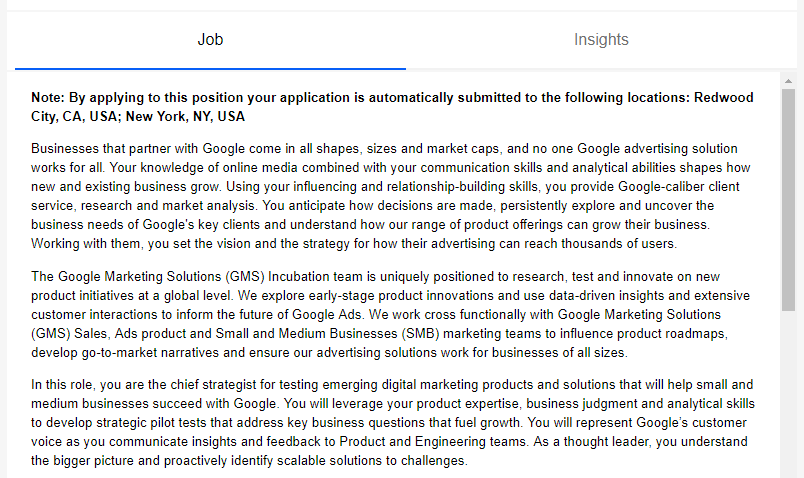
Notice how Google uses a conversational tone with plenty of “you’s”? This does a great job of explaining the job’s responsibilities and requirements.
Share internally first: Your best hires will often come from internal referrals. Before you spread the job on external job sites, share it internally. Your goal should be to
- Hire someone internally for that role, or
- Get a referral from an existing employee
Consider creating an employee referral program if you plan on hiring extensively in the near future.
Look on your ‘dormant’ talent pools: Before you share the job on job sites, tap into your existing “dormant” talent pool. This includes any channel where you have an existing presence, such as your:
- Email list
- Social media presence
- Niche community presence
Try to collect emails or applications on your careers page for future openings. This way, you will have a ready pool of interested applicants anytime a new opportunity opens up.
For example, HelpScout actively collects applications for “future openings”:
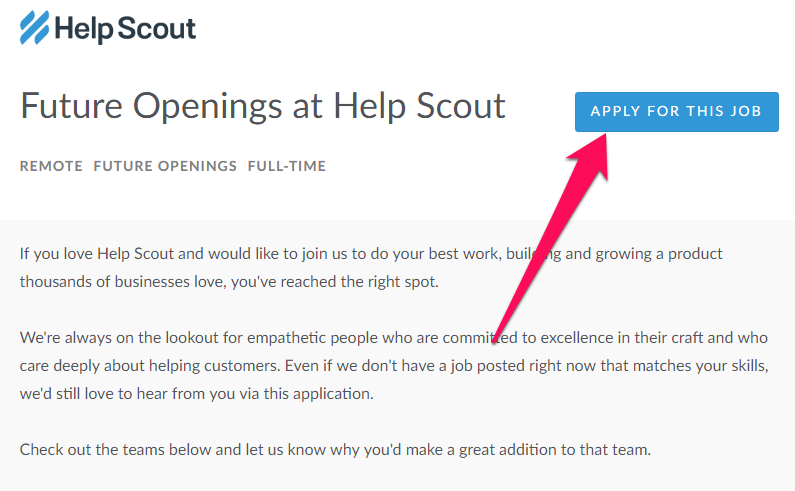
Offer relevant perks: Design your perks to be relevant to the applicant’s role and needs. If you’re trying to attract millennials, for instance, you might want to focus on free courses, dog-friendly offices, and travel opportunities.
For older employees, family leaves and work from home might be more relevant perks.
For instance, Buffer’s perks are designed largely to appeal to its younger employees:
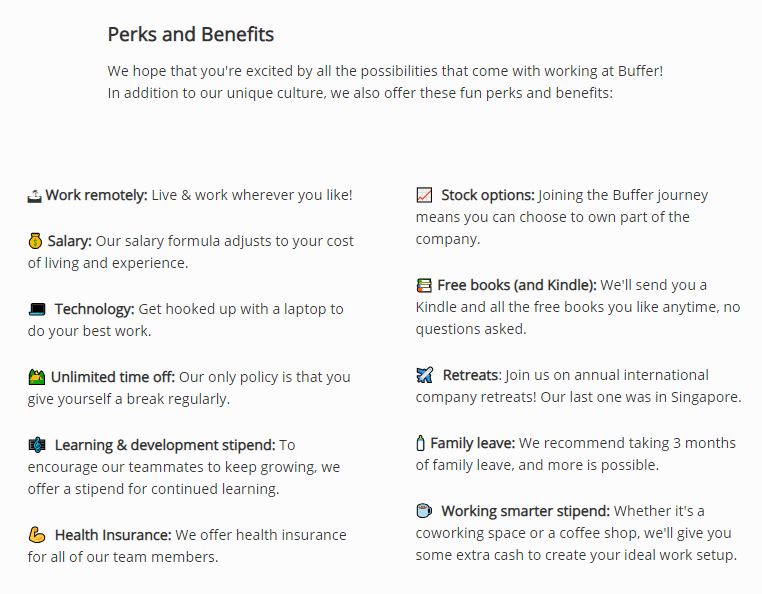
7. Clean-up Your Digital Footprint
It’s a rare employee who doesn’t Google your agency name to see what others are thinking about you (the actual figure? 80% of employees).
What if the first result he sees looks something like this?
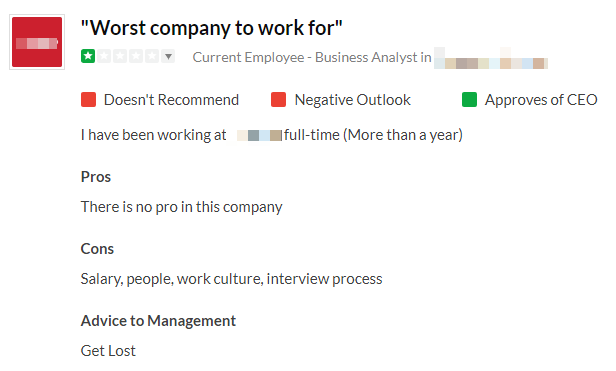
Sometimes, one-off negative reviews and experiences rise to the top of search results because you haven’t been paying attention. This can mislead potential hires into creating a false perception of your agency.
Thus, alongside building your employer brand, you also need to invest in building an attractive digital footprint. When potential hires look up your name on search engines, social media, and forums, they should get a positive picture of your company.
Here are some things you can do to clean up your digital footprint:
- Identify top websites and platforms that rank for queries related to your company name (such as “[company] reviews”). Create an outreach campaign to engage with people on these platforms (such as Glassdoor).
- Claim and control your profile on popular business-focused platforms such as Manta, LinkedIn, etc.
- Create targeted content on your own website or blog such that it shows up at the top of the SERPs.
- Maintain active profiles on social networks used by your target audience.
- Maintain an active presence on agency-focused platforms such as Clutch, UpCity, etc. since they often rank at the top of the SERPs for targeted local keywords.
Over to You
I wouldn’t be wrong to say that hiring is the single most important problem for agencies. So many issues resolve themselves when you have smart, talented people working on them.
In the face of increasing competition and inflating attrition rates, getting the right people onboard is harder than ever. These tips will help you create a hiring process that shows your agency in the best-possible light and attract top talent.
How do you hire at your agency? We’d love to know your experience in the comments below!
Business & Finance Articles on Business 2 Community
(92)
Report Post
